
9 Bushes for Beginners' Hedges
Species and varieties perfect for easily creating beautiful hedges
Contents
Not everyone can claim to be an expert gardener. However, many new homeowners also become by necessity new gardeners, whether they are happy about it or not… So what does a novice gardener do when they settle on their new plot? They plant hedges, of course! Yes, because hedges protect the little family cocoon from nosy neighbours, serve as privacy screens and windbreaks, and sometimes even hide unsightly views when the surroundings aren’t very pretty. In short, without a hedge, one doesn’t feel at home…
But when starting out in gardening, it’s clear that one doesn’t always know what to plant to create these screens of greenery. No worries, to form free or trimmed hedges, we offer here a selection of 9 hedge shrubs for beginners from our collection of easy shrubs: foolproof, requiring little maintenance and suitable for small budgets (by opting for young plants or bare roots), so that your new gardening passion brings you the satisfaction of seeing your plants thrive!
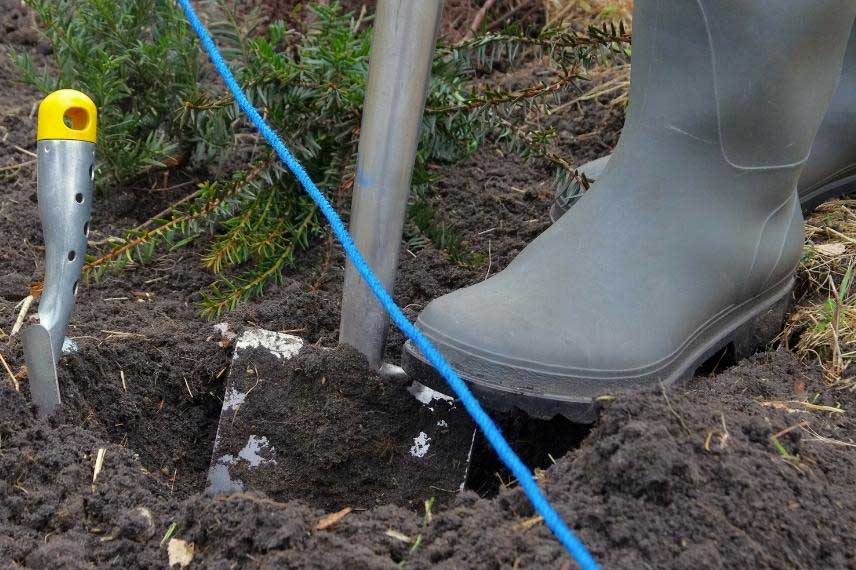
Planting the shrubs from our selection will easily guarantee you beautiful screens of greenery
Elaeagnus ebbingei - Oleaster
Among the easy-to-grow and maintain hedge shrubs, the Oleaster Elaeagnus ebbingei is a champion! It quickly forms a beautiful, densely ramified evergreen bush with lovely silver-green foliage. Hardy, robust, and undemanding, it is perfect for creating thick hedges even in poor, dry soil. It tolerates partial shade or full sun and is even suited to coastal conditions. In autumn, it bears small, almost invisible cream-white flowers, which announce their presence with their delightful honey fragrance. These flowers are highly melliferous and nectariferous.
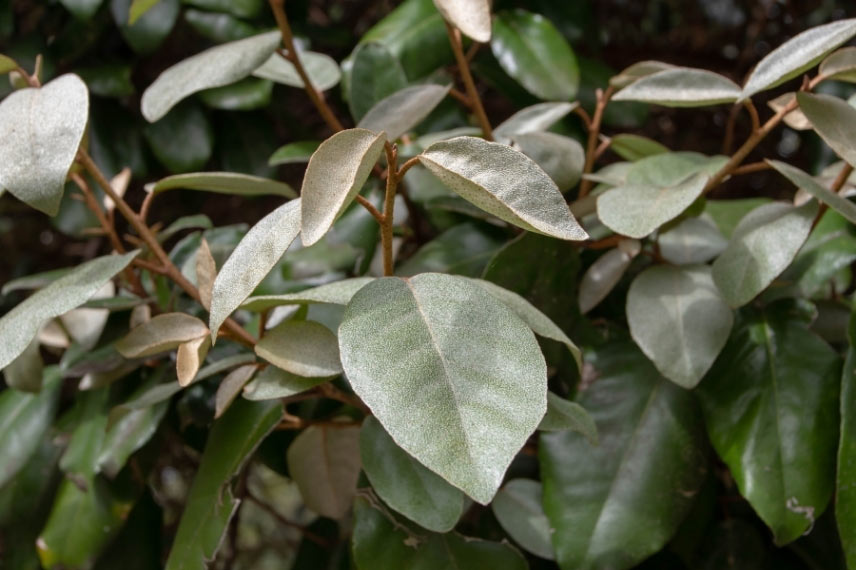
Detail of the grey-green evergreen foliage of Elaeagnus ebbingei
The Elaeagnus ebbingei in a free-standing hedge
If you have enough space, plant the Oleaster in a free-standing hedge, accompanied by evergreen shrubs (which retain their leaves all year round) and deciduous ones (which lose their leaves in winter) in a ratio of 2/3 to 1/3 respectively. Space your Eleagnus at least 1.5m apart from other shrubs to allow them to express their natural shape.
The Elaeagnus ebbingei in a trimmed hedge
If you need to control the width and/or height of your shrubs, the Elaeagnus ebbingei ‘Compacta’ is ideal. This variety of Oleaster is distinguished by its particularly dense and bushy habit and moderate growth at maturity, rarely exceeding 2m in height and 1.5m in spread. New shoots will elongate very quickly at the start of the season, displaying a decorative rusty colour with silver highlights. Plant them at a distance of between 1m and 1.2m apart. Perform a light formative pruning in the first few years, at the end of winter or in spring, then maintain the harmony of the shape thereafter, always at this time to avoid compromising the autumn flowering.
→ Need advice on pruning the Oleaster? Check out the article: Eleagnus: when and how to prune it
→ And to help you navigate the different species and varieties: How to choose your Eleagnus?
Read also
How to plant a hedge?Photinia
Even beginner gardeners recognise Photinias by their characteristic red shoots and can successfully cultivate them. These magnificent screening hedges require little maintenance and bring seasonal rhythm with their changing colours; these evergreen bushes are easy to grow. Low-maintenance, they can be planted in full sun or partial shade and prefer cool, deep soil, but they tolerate drought and lime quite well. Remarkably tolerant of repeated pruning and fast-growing, Photinia (x) Fraseri ‘Red Robin’ is an excellent evergreen hedge shrub, very popular in gardens. However, there are other interesting varieties that are equally easy to train into a hedge.

The young red shoots of Photinia are ideal for creating colourful hedges
The Photinia in a free-form hedge
‘Carré rouge’ is a variety of Photinia with denser, more colourful foliage: its young bright red leaves turn glossy green later. Although it tolerates pruning well, this shrub, reaching 3.00 m in height and 2.00 m in spread, is ideal for a free-form hedge, accompanied by other shrubs of similar growth, especially as it will develop a lovely spring flowering in white umbels if left unpruned.
The Photinia in a trimmed hedge
‘Little Red Robin’ is a small-growing cultivar of the famous Photinia fraseri ‘Red Robin’. Reaching a size of 1 m in all directions, it is ideal for low hedges. For a trimmed hedge with a bit more height (up to 2 m) and colour, consider the new cultivar ‘Magical Volcano’. It develops finely dentate young scarlet leaves that retain their stunning colour all year round, highlighting the rest of the glossy green foliage and the cream-white flowers that occur in June.
→ Find our complete guide on Photinia: Photinia: planting, pruning, and maintaining
Discover other Hedge shrubs
View all →Available in 0 sizes
Available in 1 sizes
Available in 1 sizes

Available in 1 sizes
Available in 1 sizes
Available in 1 sizes
Available in 2 sizes
Available in 1 sizes
Available in 1 sizes
Available in 1 sizes
Ligustrum ibota 'Musli' - Variegated Privet
To bring brightness to your hedge, nothing beats the Variegated Privet Ligustrum ibota ‘Musli’. Privets are known for being easy bushes, and this variety lives up to that reputation. Fast-growing and easy to cultivate in any ordinary soil, even calcareous, this shrub is more or less evergreen depending on the climate and can thrive in full sun—resulting in a more pronounced golden foliage—or partial shade. However, it prefers soils that are not too dry and well-drained. Very hardy, it easily withstands temperatures down to -15 °C and the winters of mountainous areas.

Detail of the variegated foliage of Ligustrum ibota ‘Musli’
The Ligustrum ibota ‘Musli’ in a free-form hedge
Of medium stature, with a mature height of 2.20 m and aspread of 1.80 m, the Ligustrum ibota ‘Musli’ quickly and naturally adopts a rounded and dense habit. It can therefore be placed among other deciduous and evergreen plants in an untrimmed shrub hedge to create a beautiful screen. This privet produces lovely small clusters of white flowers that are pleasantly fragrant and melliferous from June to August. It hardly flowers if trimmed, but will showcase its flowering potential in a vibrant hedge. If trimming becomes necessary after a few years, it should be done in spring and consist of removing dead wood to maintain a beautiful silhouette.
The Ligustrum ibota ‘Musli’ in a trimmed hedge
Well-suited to pruning, the variegated privet can be included in a hedge controlled in width and height. When planting, which should be done in autumn or spring, cut the plant back to 30 or 40 cm from the ground to encourage dense branching. Allow for a spacing of 80 cm to 1 m between each plant. Pruning will only be necessary once a year, or even every two years at the end of winter, to remove dry branches and shorten any overly long shoots.
→ To learn more about this genus of shrubs, check out our article: Privet or Ligustrum: Buying Guide
Cotoneaster franchetii - Franchet's Cotoneaster
Admirable and elegant, the Cotoneaster franchetii is a hardy evergreen bush with fine, highly ramified branches. Its small grey-green foliage is very dense, covering it from base to tip. Among the numerous family of Cotoneaster, Cotoneaster franchetii is remarkable for creating beautiful, low-maintenance hedges, thriving in any good garden soil that is not too dry in summer, in full sun or partial shade. Its growth is rapid, developing a slightly wider than tall habit, reaching an average height and spread of 2.50 m. It is hardy, but should still be protected from cold, drying winds. It is also interesting for its abundant, melliferous white-pink flowering that blooms in May-June, followed by numerous small red berries that remain decorative on the bush in autumn-winter.

Cotoneaster franchetii (Wendy Cutler – Flickr)
Cotoneaster franchetii in a free-form hedge
As Cotoneaster franchetii tends to adopt a rather bushy habit, prune the long shoots every year to balance it and give it a rounded shape. In a free-form hedge, allow it to grow to its natural size and be careful not to plant it too close to other bushes in your hedge, whether evergreen or deciduous, to give your hedge a lovely rustic appearance.
Cotoneaster franchetii in a trimmed hedge
Lightly prune your Cotoneaster franchetii after flowering, in July-August, to shorten the shoots that disrupt its compact habit, creating beautiful trimmed hedges. Do not remove the developing fruits if you want to enjoy their decorative aspect. This way, you will form a well-dense hedge, whether it is single-species or diverse. You can also prune it at the end of winter to limit its growth and densify it.
→ Interested in the Cotoneaster genus for creating lovely hedges? Discover other varieties in our guide: Cotoneaster: which one to choose?
Cornus sanguinea - Red-barked dogwood or Bloodtwig dogwood
The success of creating a hedge partly depends on the attractiveness you can provide throughout the year: the Cornus sanguinea, also known as the Red-wooded Dogwood or Bloodtwig Dogwood, adds stunning winter appeal to your green screen with its bright red young shoots. It is also attractive for its soft green foliage that takes on warm autumn hues. In late spring, it produces lovely white inflorescences that are highly melliferous. Perfectly hardy, truly low-maintenance regarding soil type and exposure, and with rapid growth, this bush, reaching 2 m in all directions, is easy to care for and makes remarkable hedge specimens.
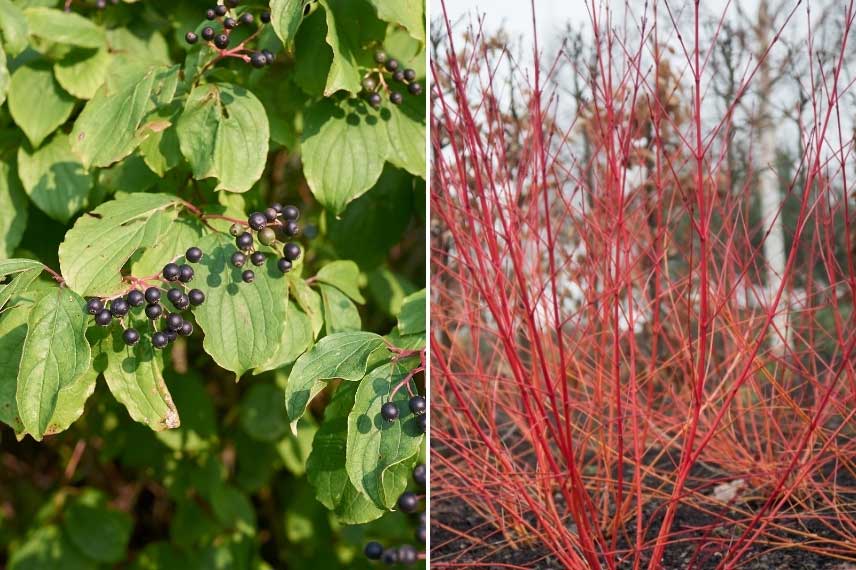
Details of the foliage and the sublime red shoots of Cornus sanguinea
The Cornus sanguinea in a free-form hedge
Only the new shoots of the year are coloured, so prune the branches to a varying length depending on the desired result. Keep in mind that its regrowth will be rapid. This pruning should be done at the end of winter.
The Cornus sanguinea in a trimmed hedge
As Cornus sanguinea tolerates pruning well, you can incorporate it into a trimmed hedge. Start by cutting your shrubs to 30 cm above the ground if you want to give them a very compact habit, then carry out an annual pruning to control their height and width.
Carpinus betulus - Hornbeam or Hornbeam Hedge
The Hornbeams are well-known trees in France. The Carpinus betulus or Common Hornbeam has the unique characteristic of possessing marcescent foliage, meaning that the dry leaves remain attached to the branches until they are replaced by new leaves in spring. The hornbeam hedge therefore has good screening power and remains decorative all year round. But that’s not all; among its qualities, this species tolerates pruning very well, helps to break the wind, and allows for the quick and cost-effective establishment (by opting for young plants in pots or bare roots) of regular and elegant hedges. It is also a very hardy and low-maintenance tree that will adapt to any sufficiently deep soil, even if it is calcareous and occasionally dry.
 The soft green foliage of a hornbeam hedge
The soft green foliage of a hornbeam hedge
The Carpinus betulus in a free hedge
The Carpinus betulus can be used interchangeably as a screen, a windbreak hedge, or in a free countryside hedge. Free from pruning, it is a tree that will adopt a port spreading, with a height at ripeness of 25 m and a width of approximately 8 m. If this size is too large for the space you have, do not hesitate to prune it each year to maintain the proportions that suit you best.
The Carpinus betulus in a trimmed hedge
Very elegant, hornbeam hedges are achieved by pruning the plants each year in June and September to remove the stems that compromise the symmetry of the whole. The resulting hedge will be well-furnished and will create impenetrable screens.
Ligustrum japonicum 'Texanum' - Texas Privet
The Ligustrum japonicum ‘Texanum’ or Texas Privet is a bush with dense foliage made up of large, glossy dark green leaves and tender green shoots. Its summer flowering, which is beautiful and fragrant with cream-white blooms, gives way to black berries that are a delight for birds. It is a solid and hardy plant, tolerating temperatures down to -15°C.
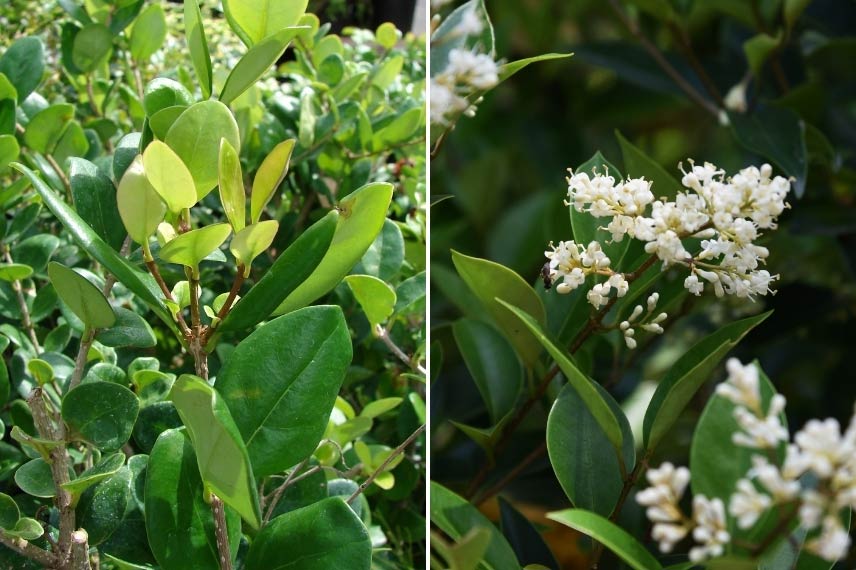
Foliage and flowers of Ligustrum japonicum ‘Texanum’
The Ligustrum japonicum ‘Texanum’ in free-standing hedge
Pruning the Texas Privet is not essential in this type of hedge, as if done at the wrong time, it can compromise flowering and/or fruiting. This subject will reach a height at ripeness of 4 m with a width of 2 m.
The Ligustrum japonicum ‘Texanum’ in trimmed hedge
In a trimmed hedge, however, shorten the new shoots by half each year to encourage good ramification of your plants. Do this after flowering in June-July.
Sambucus nigra - Black elderberry
Easy to grow, the Black Elder Sambucus nigra ‘Korsor’ is a beautiful deciduous bush with rapid growth, thriving in all types of soil, ideally rather cool. This vigorous variety produces sweet purple-black berries that can be used in jams, jellies, or juices, while the flowers can be cooked into fritters or used to make infusions.
 Sambucus nigra
Sambucus nigra
The Sambucus nigra in a free hedge
The black elder requires no special care and, when planted in a wild hedge, does not need pruning. It is ideal for this type of location, allowing it to contribute to creating varied scenes and quickly develop a bushy silhouette of 4 m high with a spread of 2 m. The speed at which it grows is a great asset for new gardens to be designed.
Crataegus laevigata Rosea 'Flore Pleno' - Wood Hawthorn
Resilient, hardy and easy to grow, the Common Hawthorn Crataegus laevigata Rosea ‘Flore Pleno’ is a stunning variety of Hawthorn that is covered in double flowers of a beautiful deep pink colour in May-June. It forms a bush with a rounded habit that rarely exceeds 6 m in height and 4 m in spread.
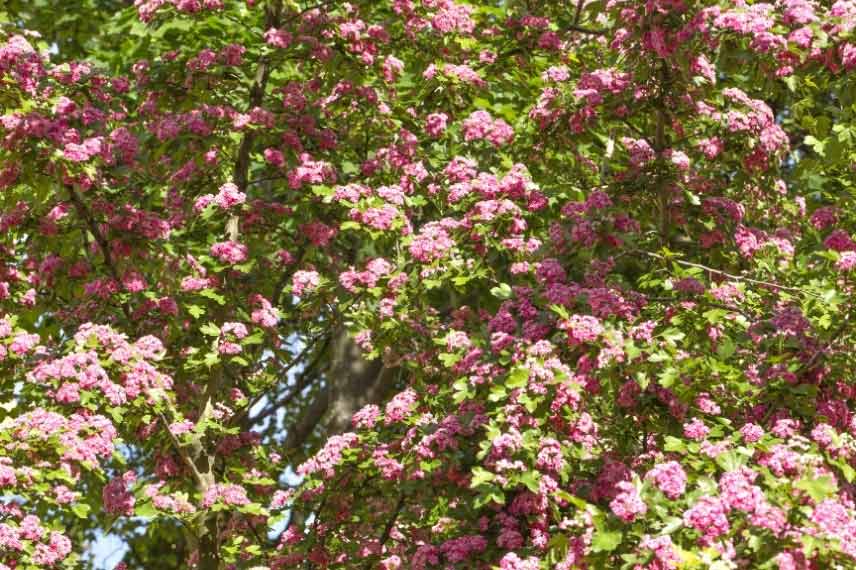
Crataegus laevigata Rosea ‘Flore Pleno’
The Crataegus laevigata Rosea ‘Flore Pleno’ in a free-standing hedge
This thorny plant is ideal for a wild hedge, alongside trees and shrubs of similar growth, both deciduous and evergreen. Low-maintenance, it will only require light pruning in February to trim back any overly long branches, maintaining a harmonious shape.
→ To create your hedge, feel free to consult our guide: How to Pair Hawthorns?
For further reading
→ Which bushes will be best suited to your project and garden? Simply answer this question using our web application Plantfit.
→ To plant a hedge correctly, an experienced gardener needs two. Find all the useful information in our sheet: Planting trees and bushes: what does the law say? 8 questions – answers.
- Subscribe!
- Contents

































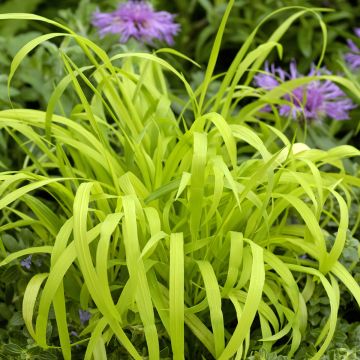
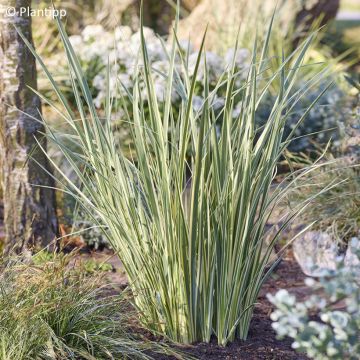
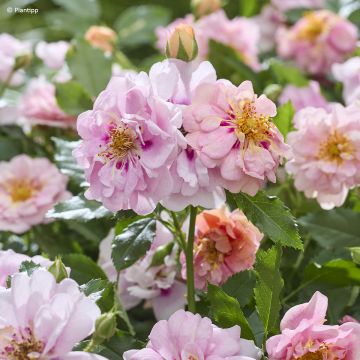

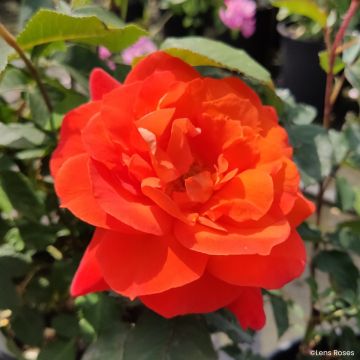
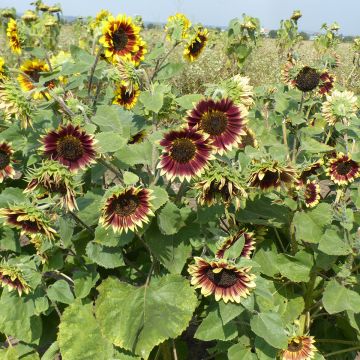
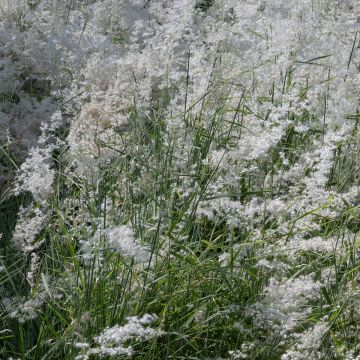
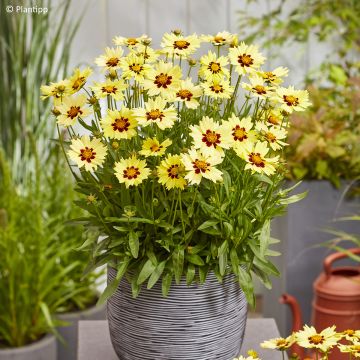
Comments